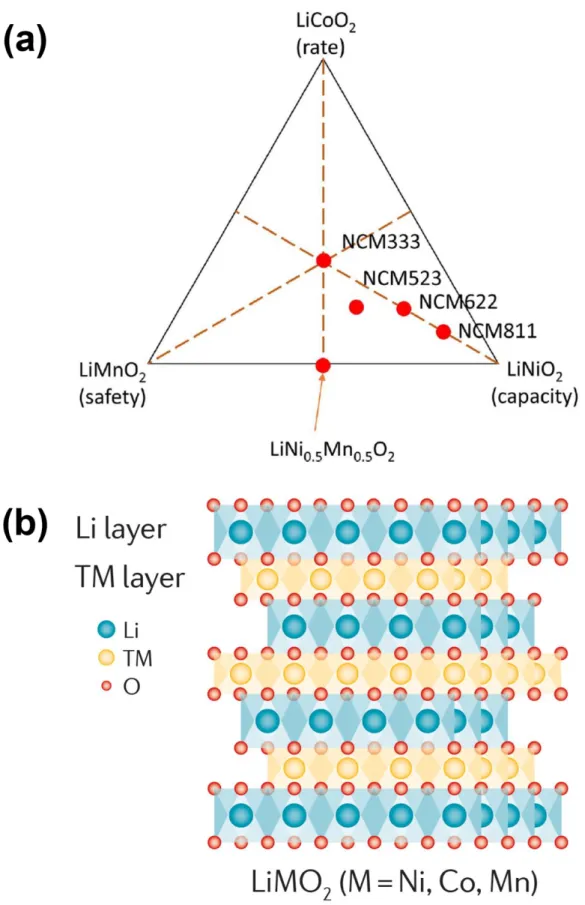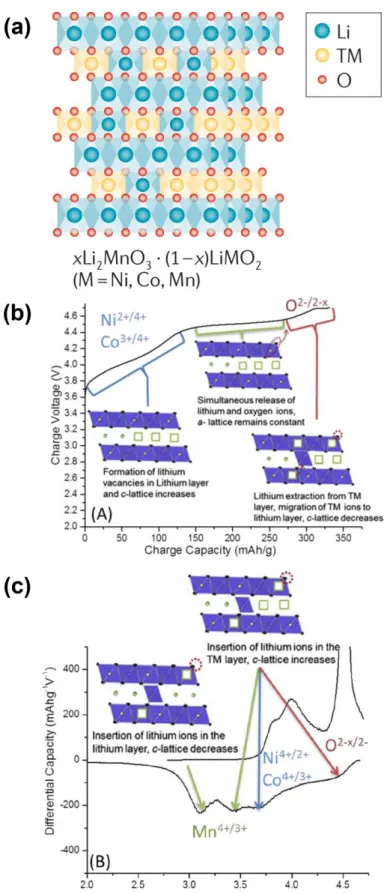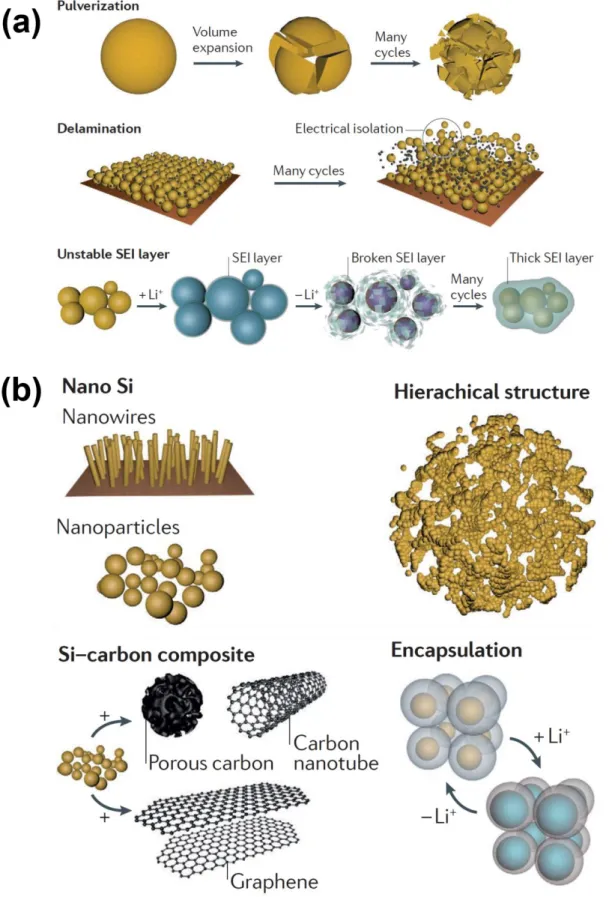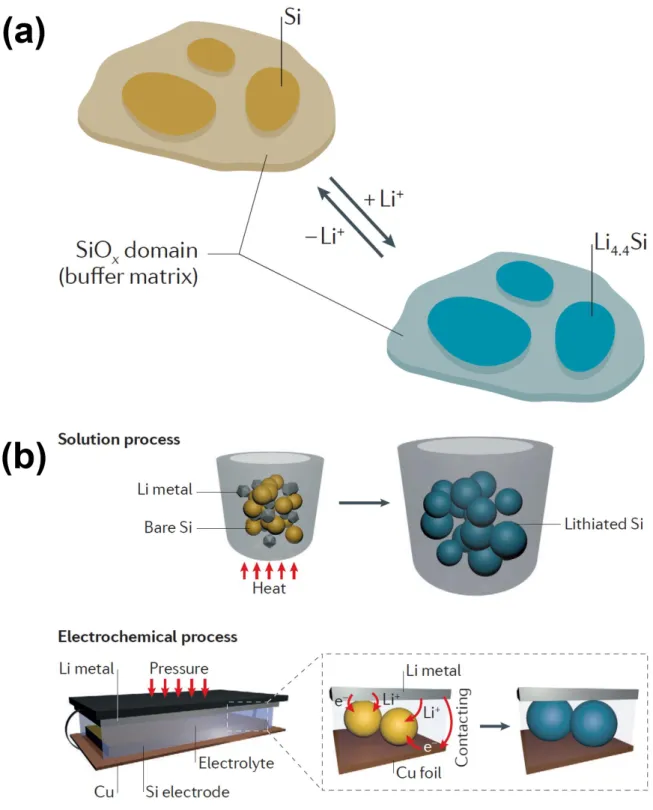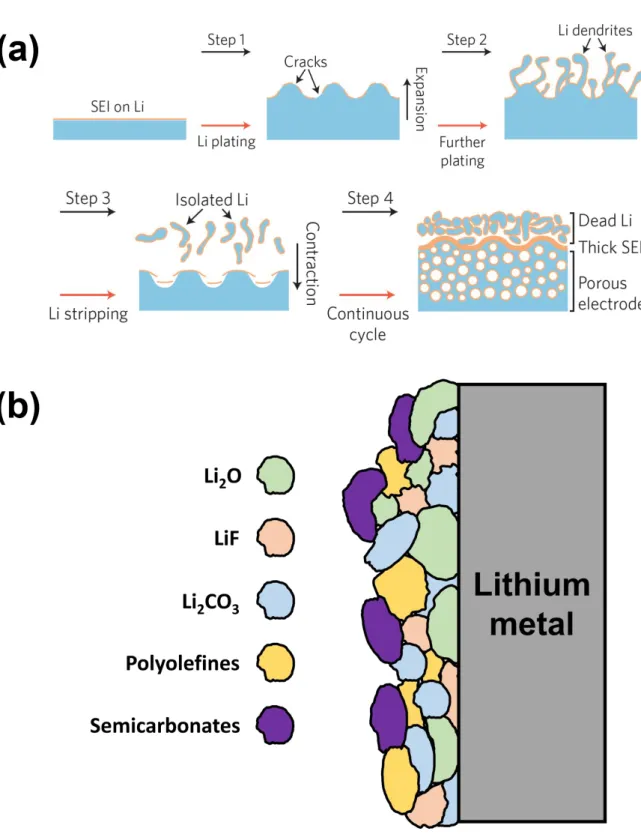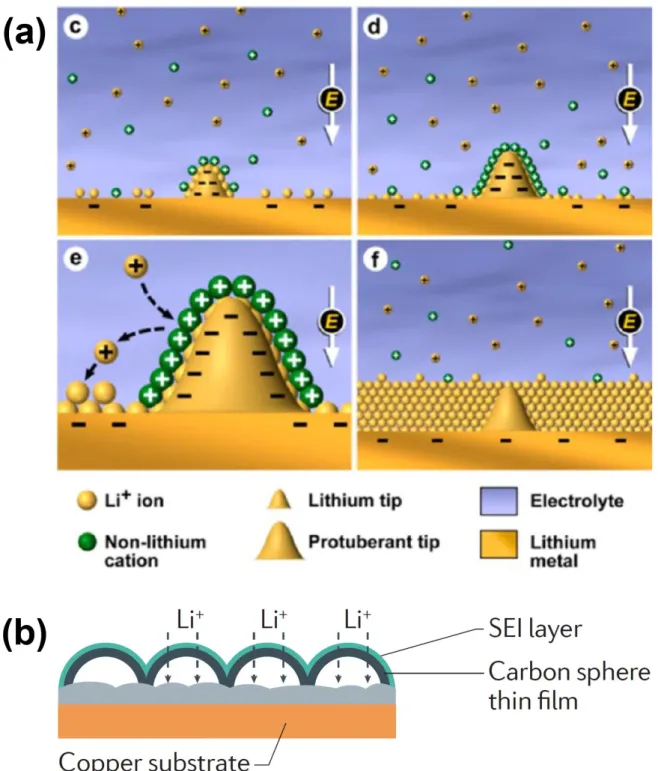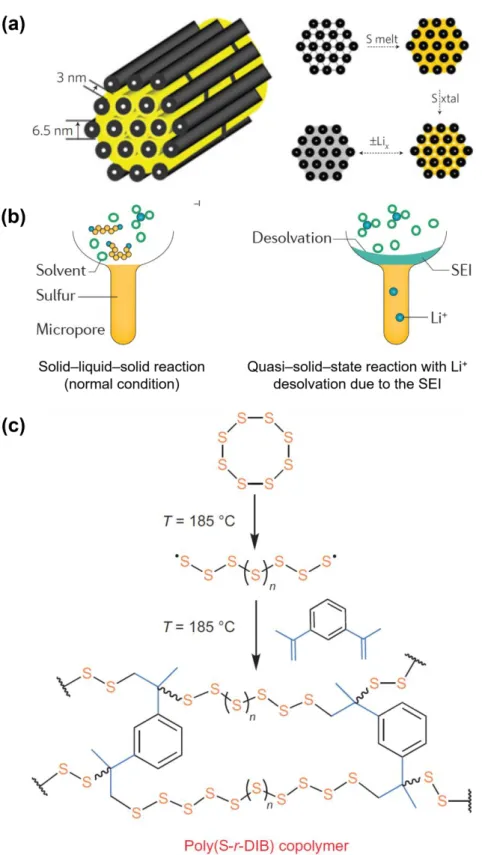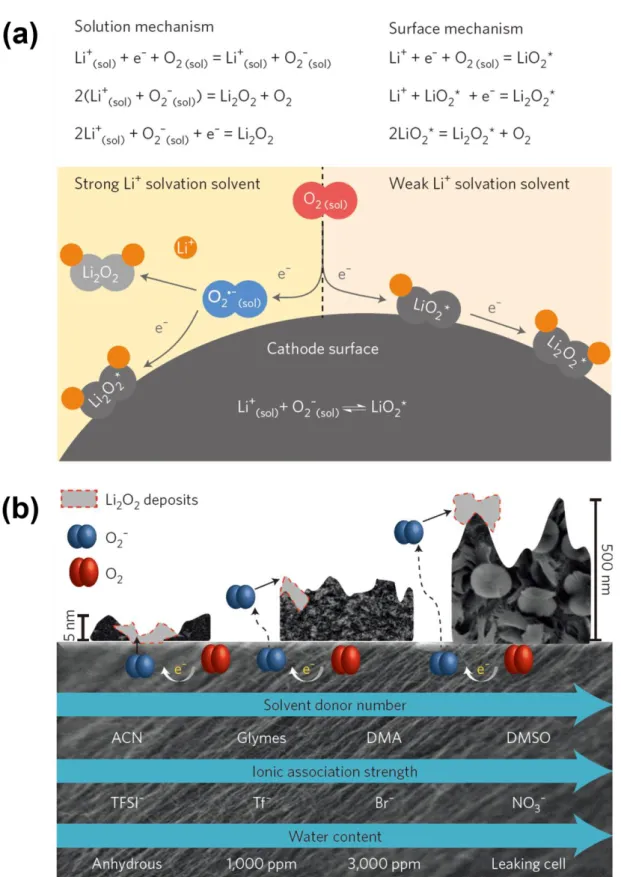23 Figure 1.12 (a) Galvanostatic voltage profile (left) and differential electrochemical mass spectroscopy (DEMS, right) analysis of Li–O2 cell-loaded Ir/rGO catalysts. Reprinted with permission from ref. d) Schematic diagram for the reaction mechanism of the Li–O2 cell containing TEMPO as a redox mediator.
Introduction
Next–generation rechargeable batteries
- Post lithium–ion batteries (PLIBs)
- Sulfur–based batteries (Li–S batteries)
Li/Li+ accompanying the evolution of oxygen.35-37 Li2MnO3 can also be represented as layered LiMO2 denoted as Li[Li1/3Mn2/3]O2, where it consists of interlaced octahedral sites occupied only by Li+ and slab octahedral sites of M4+ and occu (in an atomic ratio of 1:2) as shown in Figure 1.4a. During discharge, as shown in Figure 1.4c, Li+ first enters the TM plate at high potential.
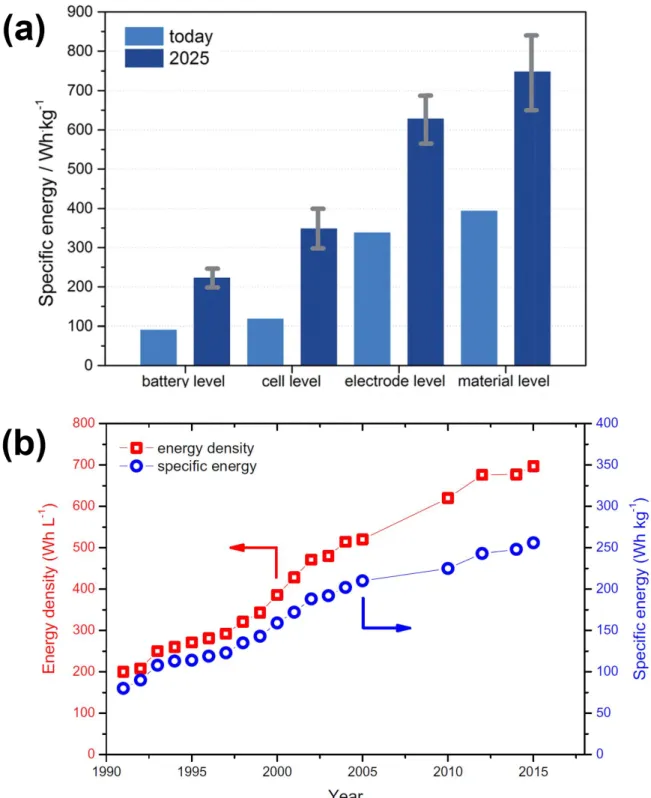
Lithium–Oxygen batteries (Li–O 2 batteries)
The non-aqueous electrolyte is required for the following properties for the ideal reaction of Li-O2 batteries:160. a) High chemical stability against reactive oxygen derivatives, such as superoxide (O2-), peroxide (O22-), its adduct (LiO2 and Li2O2), and various additives. To achieve high electrochemical performance of Li-O2 batteries, the various non-aqueous electrolytes were investigated for appropriate solvents, salts and additives. The high DN solvent, such as dimethylformamide (DMF), 171 N,N-dimethylacetamide (DMAc), 172-173 dimethyl sulfoxide (DMSO and ethyl methyl sulfone (EMS),176 as an electrolyte solvent for Li-O2 batteries have been proposed and showed excellent performance of Li–O2.
The main disadvantages of Li-O2 batteries are two: chemical/electrochemical stability related to the aforementioned electrolyte and reaction kinetics related to ORR and OER. In particular, the high polarization of Li-O2 batteries is the main problem for achieving longer cycle performance due to the slow kinetics of the OER. In addition, the high charging potential accelerates the breakdown of electrolyte and oxygen electrode corrosion, resulting in poor cycling performance of Li-O2 batteries.
These redox mediators effectively reduced the overpotential and showed extended cycle performance of Li-O2 batteries.
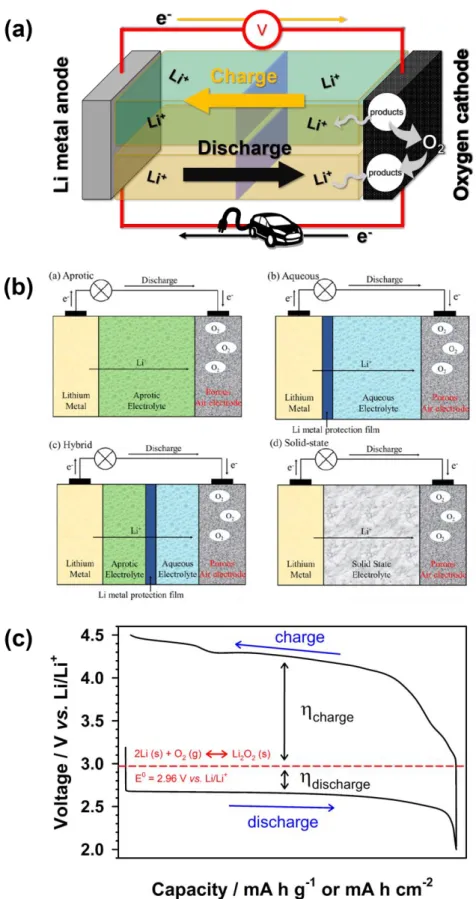
Research motivation
Characterization
Based on quantum mechanics and Planck's law, when the energy of the electromagnetic wave incident on the electron is equal to the energy gap of the electronic transition, the electron absorbs its microwave. In this context, when the microwave hits the electron, the electron absorbs the microwave with a specific wavelength which is equal to the energy gap as shown in Figure 1.13a. In general, the last method is widely used due to the technical difficulty of microwave control.
However, the g-factor information is limiting for obtaining detailed data on the geometric structure of the electron distribution. This information can be obtained from the “hyperfine interaction” between the nuclei and the electron, analogous to the NMR. This magnetic moment generates the magnetic field, which leads to the influence on the magnetic moment of the electron.
This effect of the nuclear magnetic field further splits the electron spin energy level, resulting in the splitting of the ESR signal as shown in Figure 1.13b.
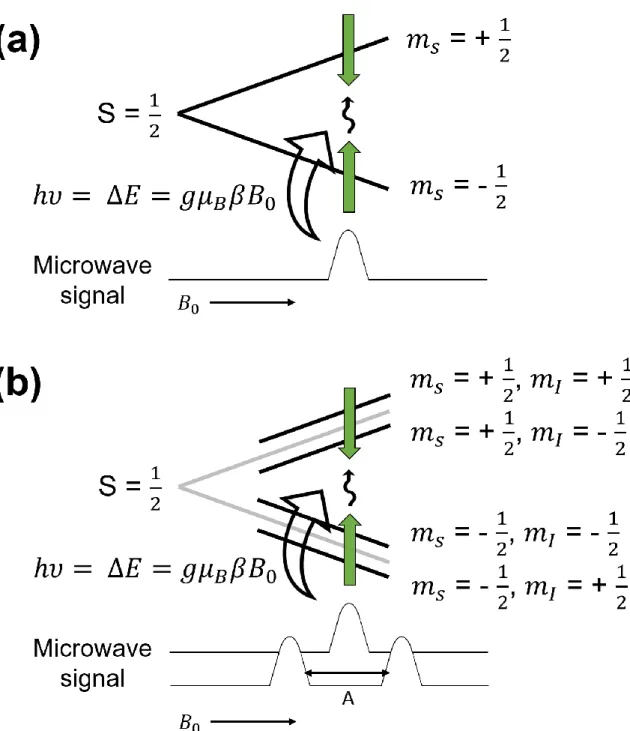
Introduction
The redox potential of MPT is 3.5 V (compared to Li/Li+) in carbonate electrolytes, which is higher than Li–O2 batteries. In addition, Zhou's group presented MPT as a redox mediator for Li–O2 batteries.203 Therefore, MPT may be suitable as a redox mediator for Li–O2 batteries. In this chapter, the electrochemical performance of MPT for Li–O2 batteries is investigated to evaluate the suitability of MPT as a redox mediator by cyclic voltammetry, galvanostatic discharge–charge, ex situ X-ray diffraction (XRD) and scanning electron microscopy (SEM).
The electrochemical performance of MPT is excellent, but their performance shows the limitation in Li–O2 batteries. This indicates that the electrochemical performance of MPT also degrades in Li-O2 batteries and is suitable as a redox model mediator to analyze the failure mechanism of Li-O2 batteries.
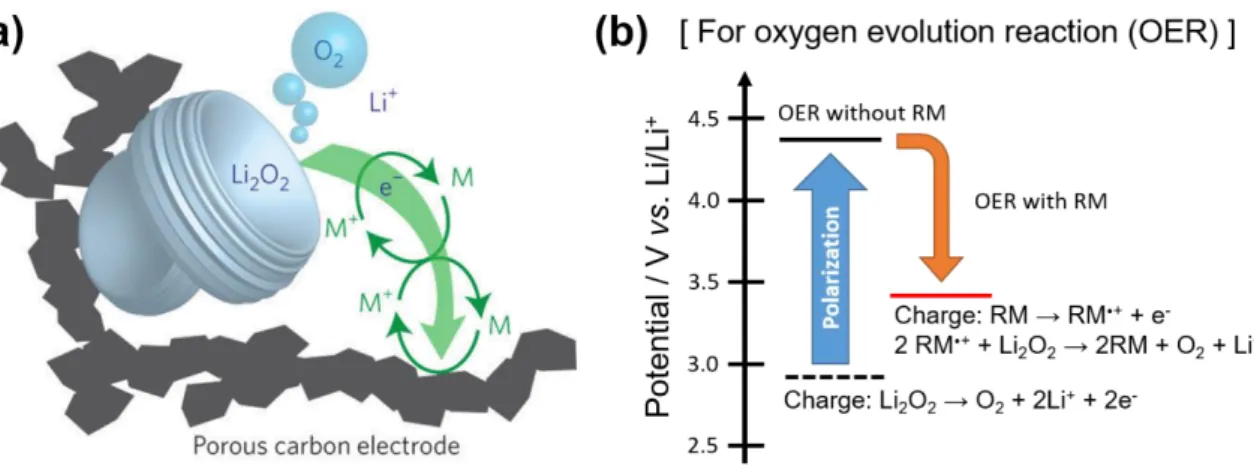
Experimental details
- Materials
- Electrode preparation
- Electrochemical characterization
- Characterization
Ex situ X-ray diffraction (XRD) patterns of oxygen electrodes collected from Li-O2 cells after cycling were obtained using a Bruker D2 PHASER with Cu Kα radiation (λ = 1.5418 Å) operated in the 2θ range of 10 to 80° with sweep step of 3455 and step time of 4 s per step. Electrodes were sealed with 100-μm-thick Be window and Kapton® tape (Dupont) in an Ar-filled glove box to prevent exposure to air. Ex situ scanning electron microscopy (SEM) images and energy dispersive X-ray spectroscopy (EDS) spectra of oxygen electrodes collected from Li-O2 cells after cycling were obtained using a JEOL JSM-7800F Prime and Oxford Instruments X -MaxN with an acceleration voltage of 15 keV and low electron (LED) detector mode.
The electrodes for SEM were prepared in the Ar-filled glove and minimized exposure to air using the sealing vial.
Result and Discussion
Cyclic voltammograms of the MPT under (b) Ar and (c) O2 atmospheres at a scan rate of 50 mV s-1 in the voltage range between 2.0. The figures in Figure 3.2b correspond to the figures in Figure 3.2a, indicating collected oxygen electrodes from the end of discharging or charging the Li-O2 cells with MPT-free and -containing electrolytes. The higher magnification ex situ scanning electron microscope (SEM) and its energy dispersive X-ray spectroscopy (EDS) mapping images of collected oxygen electrode from the Li-O2 cells with (c) MPT-.
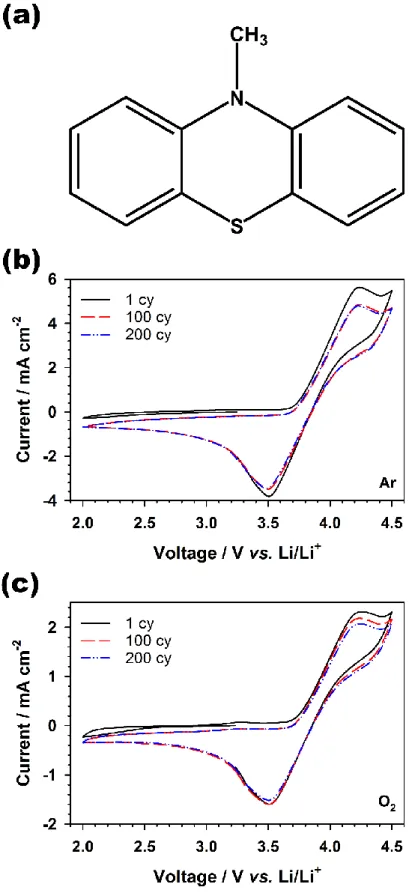
Summary
The appropriate electrolyte solvent for redox mediator in the Li–O 2 batteries
- Introduction
- Experimental details
- Materials
- Electrode preparation
- Electrochemical characterization
- Characterization
- Result and Discussion
- Summary
The redox peaks of MPT in tetraglyme- and monoglyme-based electrolyte were changed depending on the scan rate, indicating the irreversible reaction as shown in Figure 3.2a and b. Moreover, the polarization of redox reaction of MPT in monoglyme-based electrolyte slightly increased than for MPT in tetraglyme. The change of redox reaction of MPT depending on the solvent shows that the DMAc- and DMSO-based electrolyte is more suitable for Li-O2 batteries with redox mediator than glyme-based electrolytes due to the increased reversibility of MPT in the solvents.
The position of the redox peak of MPT in a tetraglyme-based electrolyte changed while changing the scan rate, indicating that the electrochemical reaction of MPT in a tetraglyme is irreversible. However, the redox potential of MPT in DMAc- and DMSO-based electrolyte shifted to higher potential than the theoretical redox potential of MPT, as a result, the use of these solvents for Li-O2 batteries with MPT has no benefit for improving the efficiency of energy. Interestingly, the relationship between the electrochemical reversibility of MPT and the chemical stability of MPT•+ with the type of solvent is inversely related.
These results indicated that the cycle performance of Li–O2 batteries with MPT is closely related to the chemical stability of MPT•+.
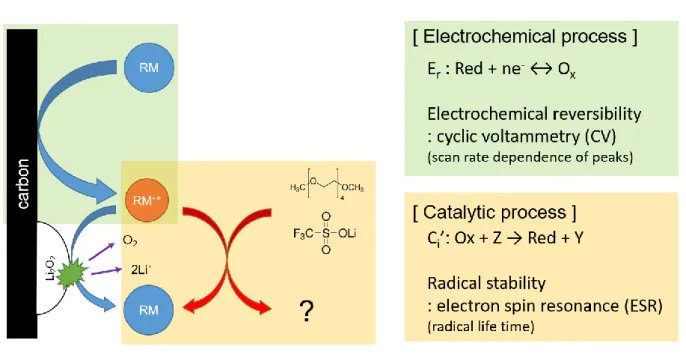
The stability of redox mediator with lithium metal anode for Li–O 2 batteries
Introduction
Experimental details
- Materials
- Electrode preparation
- Electrochemical characterization
- Characterization
Galvanostatic experiments of symmetric Li cells containing oxidized MPT (radical MPT, MPT•+) were performed using a home-made five-electrode cell consisting of two Li electrodes for the symmetric cell experiment, a glassy carbon rod as a working mesh, 316 SUS. as counter and Li0.5FePO4 as reference electrode. Li plating/stripping in the symmetric Li cell in the five-electrode cell was performed with a current density of 88 μA cm-2 and a constant capacity of 44 μA h cm-2 over 50 cycles. After the symmetric Li cell was cycled up to 50 cycles, MPT was oxidized to MPT•+ by applying a constant voltage at 3.7 V (vs. Li/Li+) for 72 h using the three-electrode cell to the five-electrode cell.
The ex situ 1H nuclear magnetic resonance (NMR) analysis of collected 1 ml of electrolyte from the homemade three-electrode cell after every three cycles of cyclic voltammetry for a month interval. Acetone-d6) with the internal reference of tetramethylsilane (TMS). The chemical components of the Li metal surface are immersed in tetraglyme electrolyte containing 1.0 M LiSO3CF3 under Ar and O2. The in situ electron spin resonance (ESR) analysis was performed using a home-made 3-electrode cell consisting of Au electrode, 316 SUS mesh and Li metal as working, counter and reference electrode, respectively.
The 3-electrode cell is filled with the 550 μl MPT containing electrolytes, such as tetraglyme electrolyte containing 1.0 M LiSO3CF3, 50 mM MPT or MPT-free and 50 mM NaNO2.
Result and Discussion
- Failure mechanism of Li–O 2 cells containing a redox mediator
- Redox mediator protection
Upon exposure of Li metal to MPT•+ , the symmetric Li cell immediately shows a significantly large polarization of ca. After adding NaNO2 to the electrolyte, the reduction peak of MPT•+ was not observed without scan rate dependence as shown in Figure 4.8c. Moreover, despite the electrochemical reaction of MPT•+ not existing, the redox reaction of MPT with the NaNO2-containing electrolyte showed high reversibility over 200 cycles without the change of the intensity of the oxidation peaks for MPT, as shown in Figure 4.8d.
This chemical reaction between MPT•+ and NO2– was also demonstrated by the electron spin resonance (ESR) analysis of MPT•+ change as shown in Figure 4.9. However, the strong signal of MPT•+ appeared after the electrochemical oxidation at a constant voltage of 3.8 V (versus Li/Li+). Therefore, the results of the cyclic voltammograms and the ESR support our suspicion that MPT in the Li‒O2 cells with LiNO3 is not decomposed on the Li metal, because NO2– obtained from LiNO3 in the electrolyte the MPT•+ that in the Li metal.
In addition, the effect of LiNO3 against the decaying Li oxide protective layer on the Li metal anode with MPT•+ was also demonstrated by studying the electrochemical performance of a Li symmetric cell using a tetraglym electrolyte containing LiNO3, MPT•+ and O2, as shown in Figure 4.10 .
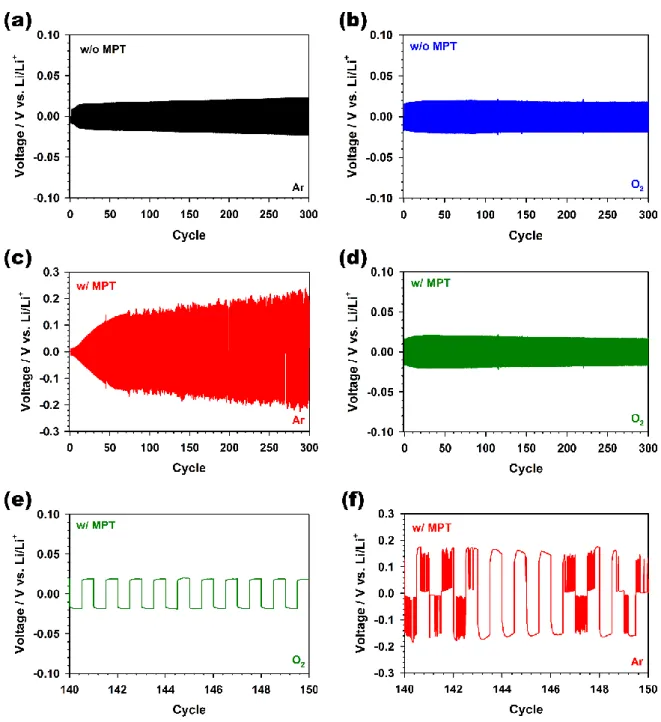
Summary
Conclusion
H.; Manthiram, A., Effect of Ru substitution on the first charge-discharge cycle of lithium-rich layered oxides. Y.; Park, I.; Back, C., Recent advances in the electrolytes for interfacial stability of high-voltage cathodes in lithium-ion batteries. G.; Chang, H., Silicon carbide-free graphene growth on silicon for lithium-ion battery with high volumetric energy density.
T.; Cui, Y.; Bao, Z., Self-healing chemistry enables stable operation of silicon microparticle anodes for high-energy lithium-ion batteries. L.; Yan, X.; Zhao, X.; Chen, X., Tertiary butyl hydroquinone as a new additive for SEI film formation in lithium-ion batteries. Liu, Y.; Lin, D.; Liang, Z.; Zhao, J.; Yan, K.; Cui, Y., Lithium coated polymeric matrix as a minimal volume change and dendrite-free lithium metal anode.
Markevich, E.; Salitra, G.; Rosenman, A.; Talyosef, Y.; Chesneau, F.; Aurbach, D., The effect of a solid electrolyte interphase on the operating mechanism of lithium-sulfur batteries.
